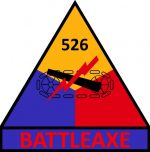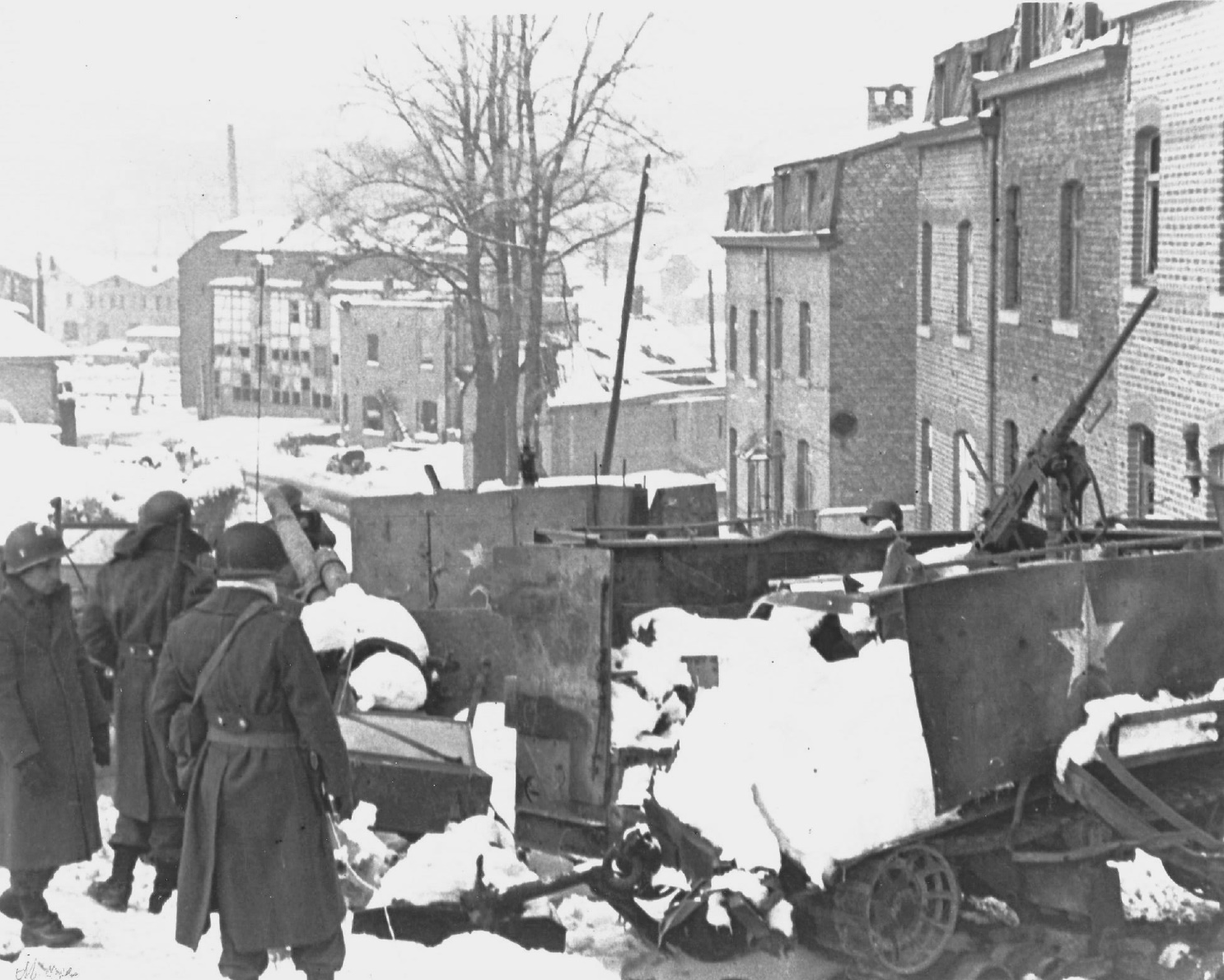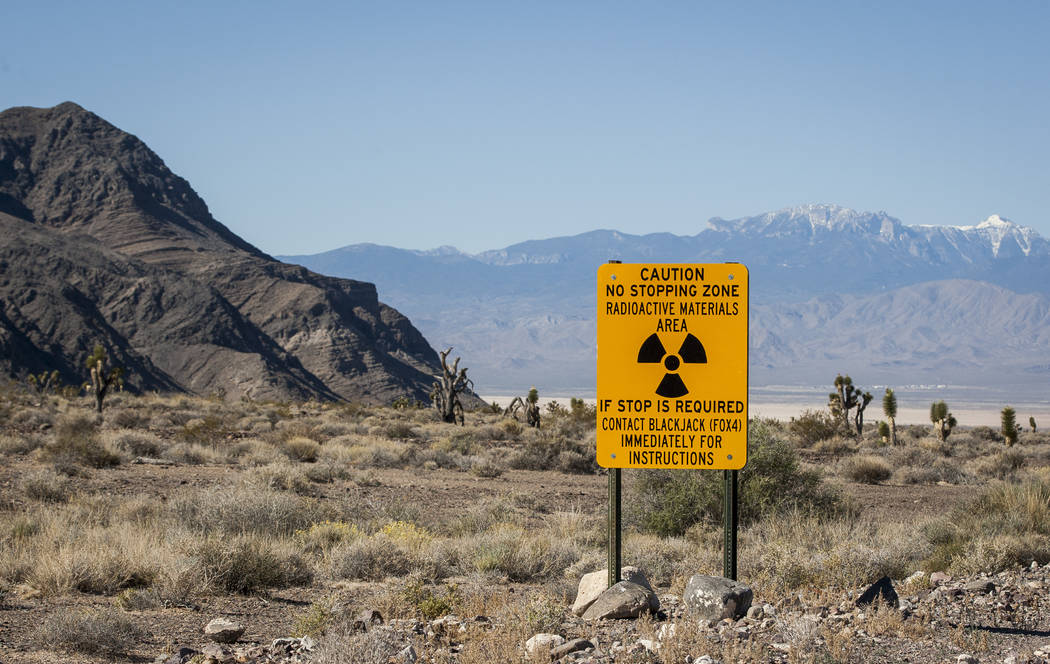
 However, during the night of December 17-18, 1944 at the Battle of the Bulge, a company of the 526th Armored Infantry Battalion, without CDL tanks, under the command of Maj Paul J. Solis, with a platoon of towed three-inch tank destroyers was sent to Stavelot, Belgium, where the head of Obersturmbannfuhrer (Lt Col Waffen-SS) Jochen Peiper’s column lay. Just before daybreak, Maj Solis began moving his unit into position, placing two platoons on the south bank of the Ambieve River, a section of tank destroyers at the old roadblock, and one platoon with three 57-MM antitank guns and the second section of tank destroyers in reserve around the town square north of the Ambieve River. Before his troops were completely organized, the Nazi infantry attacked.
However, during the night of December 17-18, 1944 at the Battle of the Bulge, a company of the 526th Armored Infantry Battalion, without CDL tanks, under the command of Maj Paul J. Solis, with a platoon of towed three-inch tank destroyers was sent to Stavelot, Belgium, where the head of Obersturmbannfuhrer (Lt Col Waffen-SS) Jochen Peiper’s column lay. Just before daybreak, Maj Solis began moving his unit into position, placing two platoons on the south bank of the Ambieve River, a section of tank destroyers at the old roadblock, and one platoon with three 57-MM antitank guns and the second section of tank destroyers in reserve around the town square north of the Ambieve River. Before his troops were completely organized, the Nazi infantry attacked.
Taken by surprise, the Americans failed to destroy the bridge and, in short, the order was driven back into the center of Stavelot. Maj Solis’ defense held the town square for some time and a two-hour tank battle caused heavy losses to both sides as well as to the civilian population which had not been evacuated yet, but by the end of the morning, the Americans were driven from Stavelot. In the confusion of pulling back, Solis’ detachment moved eastward along the Spa Road towards the Francorchamps gas dump which originally contained 2 million gallons of gasoline. Knowing he could not stop Peiper’s armor, Solis came up with an ingenious gambit. He had his men pour some of the fuel into a deep road cut and set it ablaze. Peiper’s lead tanks, unable to cross the configuration, turned back.

 Other 526-AIB units were made a part of Col Francis T. Tompkins’ T Force, a small, specialized unit of 300 men, hardly the type designed for heavy combat and later assigned to the 30-ID. On December 18, Charlie 526 AIB was given a mission destined to have a major impact on the Ardennes battle when it was ordered to the small town of Trois-Ponts. Commanded by Maj Robert Yates, Executive Officer, 51-ECB, the advanced section arrived at 2330 and made preparations to blow two of the bridges at Trois-Ponts.
Other 526-AIB units were made a part of Col Francis T. Tompkins’ T Force, a small, specialized unit of 300 men, hardly the type designed for heavy combat and later assigned to the 30-ID. On December 18, Charlie 526 AIB was given a mission destined to have a major impact on the Ardennes battle when it was ordered to the small town of Trois-Ponts. Commanded by Maj Robert Yates, Executive Officer, 51-ECB, the advanced section arrived at 2330 and made preparations to blow two of the bridges at Trois-Ponts.
 Maj Yates found a (7-AD) wandering 57-MM antitank gun and crew lost from their parent unit and placed them forward of the Amblève Bridge. The gun dueled with Peiper’s Tiger tanks, disabling the lead tank (#222) before the crew was killed by another German tank fire. The crew gave a warning to the engineers who literally blew the bridge in the face of Peiper’s lead tank.
Maj Yates found a (7-AD) wandering 57-MM antitank gun and crew lost from their parent unit and placed them forward of the Amblève Bridge. The gun dueled with Peiper’s Tiger tanks, disabling the lead tank (#222) before the crew was killed by another German tank fire. The crew gave a warning to the engineers who literally blew the bridge in the face of Peiper’s lead tank.
Charlie 526 settled down to a defensive position and effectively used various ruses to convince Peiper he was facing heavy armor. The blowing of the bridges over the Salm and Amblève was a bitter disappointment to Peiper, as he later said, If we had captured the bridge at Trois-Ponts intact and had enough fuel, it would have been a simple matter to drive through to the Meuse River early that day. Later on in the war, the 738th Tank Battalion used 13 Gizmos to illuminate the Rhine River after the capture of the Remagen Bridge.
 One German officer interrogated after the war reported that We wondered what those lights were as we had the hell shot out of us while we tried to destroy the bridge… The British used their CDL vehicles during a major crossing of the Rhine at Rees where the Grant CDL tanks drew heavy fire with one tank being destroyed. Another group was used to cover the British and American crossing of the Elbe River at Laurenbug and Bleckede. The 43rd Royal Tank Regiment was deployed to India to take part in the planned night invasion of Malaya scheduled for February 1946. This regiment, completely equipped with CDL tanks, sent a squadron into the Calcutta riots of 1946 cooperating with police and local forces with great success. The US 9th Armored Group’s CDL tanks were mostly withdrawn from active service by late 1944 with the majority of these vehicles being destroyed in a large fire at the tank park in Cherbourg, France. They are now the foundation for the present-day Cherbourg city dump!
One German officer interrogated after the war reported that We wondered what those lights were as we had the hell shot out of us while we tried to destroy the bridge… The British used their CDL vehicles during a major crossing of the Rhine at Rees where the Grant CDL tanks drew heavy fire with one tank being destroyed. Another group was used to cover the British and American crossing of the Elbe River at Laurenbug and Bleckede. The 43rd Royal Tank Regiment was deployed to India to take part in the planned night invasion of Malaya scheduled for February 1946. This regiment, completely equipped with CDL tanks, sent a squadron into the Calcutta riots of 1946 cooperating with police and local forces with great success. The US 9th Armored Group’s CDL tanks were mostly withdrawn from active service by late 1944 with the majority of these vehicles being destroyed in a large fire at the tank park in Cherbourg, France. They are now the foundation for the present-day Cherbourg city dump!
California – Arizona Maneuver Area (CAMA)
Camps Locations – But Be Careful!
Traces of the many posts associated with the Desert Training Center are still visible and are very remote even by modern standards. Should you decide to visit these old abandoned military posts, take the proper safety precautions and we recommend you use a four-wheel vehicle.
Area A posts can easily be reached and we suggest you begin your trip at Blythe, California. Blythe Army Air Field was first occupied by the 46th Bomb Group and later the 34th Bomb Group (Heavy). Now the city airport, the field is just west of town on Interstate 10. DB-7, B-17, B-24, A-31, and A-36 (forerunner of the famous F-51) aircraft were assigned to Blythe AAF at various times. The local FAA Flight Service Station is very helpful if you have questions. There are a few buildings and one hangar remaining from World War II. Also in Blythe is Gary Field, a primary flying school that was operated by the Morton Air Academy during the War. Follow the road to the Blythe golf course and you will see the former flying school on your left. Many a love affair for the B-17 and B-24 aircraft began here.
Wonder how many who were stationed here knew of Ehrenberg, Arizona, and its military heritage?
Camp Young, California, Headquarters DTC (CAMA) is just northeast of the intersection of Interstate 10 and California route 195, 69 miles west of Blythe. From Desert Center, California, 47 miles west of Blythe on Interstate 110, go north on California route 177 watching for an orchard approximately five miles north and immediately adjacent to the right of the highway. Just as you clear the orchard, the road into Desert Center Army Airfield will appear. Turn right and drive to the airport beacon tower. Aside from a few modern buildings, there are numerous foundations to visit.
Camp Coxcomb, California, is approximately 15 miles north of Desert Center. Route 177 will make a 45-degree left turn and after passing a small ranch on your right watch for a hard-surfaced road on the left that leads to the California Aqueduct tunnel. Turn west (left) and go to the end where you will be on the southern edge of the old post. The 7th Armored Division, 93rd, and 95th Infantry Divisions were here at separate times during their stay in the desert. You can leave either by returning to route 177 or following the power line road north to its intersection with route 177. The Palen Pass road is readily visible on your right and does not attempt to make this trip unless you have a four-wheel vehicle. Follow the road east and south for approximately 18 miles to the fortifications that remain there.
Watch for nails, barbed wire, and so on that will cut through modern tires! Stop for a moment under the power line on route 177 and look south for a magnificent panoramic view and let your imagination bring forth the memory of men and equipment maneuvering in the hot climate.
Camp Iron Mountain and Camp Granite are just east of where Route 177 intersects with Route 62 (the Twentynine Palms road). The 3-AD trained at Camp Iron Mountain and you can enter by following the power line road or by going to the Iron Mountain Pumping Station road eight miles east.
Approaching the aqueduct, Camp Iron Mountain will be on your left and Camp Granite on your right. Both are readily visible from the highway. Camp Iron Mountain has been fenced by the Bureau of Land Management to keep vehicles out, but there are pedestrian gates at several points.
The post chapel is on the furthermost northwest corner and a large relief map of the DTC is inside the chain link fence on the northeast part of the old post. Look south across Camp Granite where there were ranges and additional maneuver areas. Camp Granite was first used by the 76th Field Artillery Brigade and later by the 90th Infantry Division when the permanent camp was completed.
The Freda Railhead is 12 miles east along route 62 and worthy of a visit. You will cross the California Aqueduct and turn right (south) along the road just after you cross. Follow this road approximately 150 yards until reaching the 484th QM Battalion compound. The area and unit insignia are in remarkable condition. Continue east towards Rice, California, and observe the areas on both sides of the highway which were a large quartermaster depot.





















